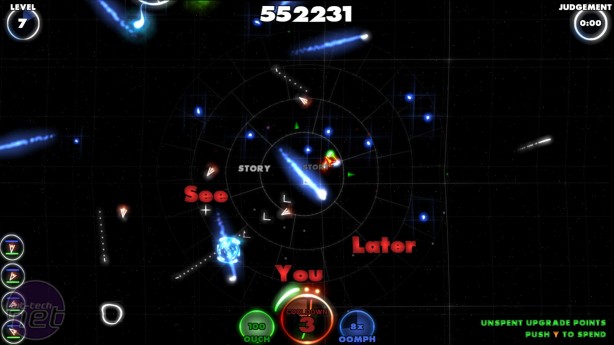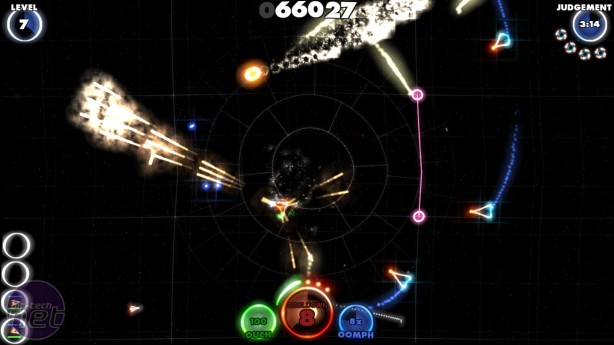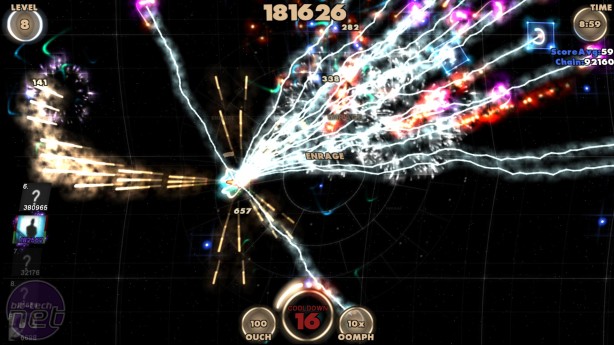
But you won't comprehend any of this until at least a third of the way through the campaign. Bezier certainly doesn't hang around, introducing nearly all of its major ideas in the tutorial level. Even during its initial instruction, the game throws what seems like a terrifying number of enemies your way. You move around the black 2D plane using one analogue stick, and aim and shoot your gun using the other. The Principle is also equipped with an "Autoaim" weapon, which fries enemies automatically but depletes your energy reserves with frightening speed, while special weapons such as missiles, freeze-rays and a protective ball-and-chain can be picked up at various points around the level. Success in Bezier involves alternating between these various weapons to fend off the armies of opponents the game throws your way.
It isn't simply the number of enemies which makes Bezier such an assault on your retinas, but their dazzling variety. There are over a hundred types of foe, all resembling molecules in terms of design, such as a bacterium or a cell or a strand of DNA. What's more, each enemy behaves in a slightly different way, some can shoot tiny bolts of energy while others might only do contact damage, some can be killed in a single shot while others take longer to destroy. Of course, none of this information registers consciously while playing. You're often fighting half a dozen different enemy types at any one time, and as a consequence you're acting largely on instinct, spitting out great loops of death with the right analogue stick as you duck and weave through tiny gaps in the ranks of this subatomic army.
At the core of Bezier is a simple mantra - "Never stop." Never stop moving. Never stop shooting. Never stop collecting the tiny "Ouch" and "Oomph" gems that replenish your health and increase your damage output respectively. Never stop seeking out the "Shields", which must all be destroyed on a given level before the timer runs out. As the clock ticks inexorably down, the music intensifies and so too does the action, resulting in a brilliant shower of colour as the computer's digital organisms swarm you like hornets and you blast them back into the codebase (that's exactly how computers work shut up). It's an experience that crawls deeper and deeper into your skull until you blink your screen-burned eyes and realise that half an hour has passed.
There are some issues. The campaign is very short, although the endurance and daily challenge modes ensure there's plenty of reason to return after the credits roll, and Bezier is an ideal game for dipping into for a few minutes every day. A bigger issue is that, while the story is well written, I wasn't always clear on what was happening because most of my mind was distracted by simply staying alive. Blending frenetic action with biblical allegory could work brilliantly, but the latter needed more explication in order for this to succeed. Finally, I don't like the font used for most of the in-game text at all. This may sound petty, but it appears a lot, and I found that it jarred with the game's otherwise very sleek aesthetic, like a booker-prize winning novel typed up in Comic Sans.
Fortunately, Bezier transcends these flaws through its exuberant visual design and blistering, hypnotic action. Eight years in development, in some ways Bezier is a fitting counterpoint to another recent, slow-cooked indie release, The Witness. Both games begin from a point of disorder and confusion, yet slowly reveal a clearly ordered structure within that apparent chaos. Whereas The Witness unfurls over the course of hours, Bezier deals in seconds and minutes, and the seemingly infinite space between them.
It isn't simply the number of enemies which makes Bezier such an assault on your retinas, but their dazzling variety. There are over a hundred types of foe, all resembling molecules in terms of design, such as a bacterium or a cell or a strand of DNA. What's more, each enemy behaves in a slightly different way, some can shoot tiny bolts of energy while others might only do contact damage, some can be killed in a single shot while others take longer to destroy. Of course, none of this information registers consciously while playing. You're often fighting half a dozen different enemy types at any one time, and as a consequence you're acting largely on instinct, spitting out great loops of death with the right analogue stick as you duck and weave through tiny gaps in the ranks of this subatomic army.
At the core of Bezier is a simple mantra - "Never stop." Never stop moving. Never stop shooting. Never stop collecting the tiny "Ouch" and "Oomph" gems that replenish your health and increase your damage output respectively. Never stop seeking out the "Shields", which must all be destroyed on a given level before the timer runs out. As the clock ticks inexorably down, the music intensifies and so too does the action, resulting in a brilliant shower of colour as the computer's digital organisms swarm you like hornets and you blast them back into the codebase (that's exactly how computers work shut up). It's an experience that crawls deeper and deeper into your skull until you blink your screen-burned eyes and realise that half an hour has passed.
There are some issues. The campaign is very short, although the endurance and daily challenge modes ensure there's plenty of reason to return after the credits roll, and Bezier is an ideal game for dipping into for a few minutes every day. A bigger issue is that, while the story is well written, I wasn't always clear on what was happening because most of my mind was distracted by simply staying alive. Blending frenetic action with biblical allegory could work brilliantly, but the latter needed more explication in order for this to succeed. Finally, I don't like the font used for most of the in-game text at all. This may sound petty, but it appears a lot, and I found that it jarred with the game's otherwise very sleek aesthetic, like a booker-prize winning novel typed up in Comic Sans.
Fortunately, Bezier transcends these flaws through its exuberant visual design and blistering, hypnotic action. Eight years in development, in some ways Bezier is a fitting counterpoint to another recent, slow-cooked indie release, The Witness. Both games begin from a point of disorder and confusion, yet slowly reveal a clearly ordered structure within that apparent chaos. Whereas The Witness unfurls over the course of hours, Bezier deals in seconds and minutes, and the seemingly infinite space between them.


MSI MPG Velox 100R Chassis Review
October 14 2021 | 15:04













Want to comment? Please log in.